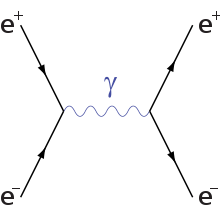Positron annihilation spectroscopy
| Condensed matter experiments |
|---|
 |
| ARPES |
| Neutron scattering |
| X-ray spectroscopy |
| Quantum oscillations |
| Scanning tunneling microscopy |
Positron annihilation spectroscopy (PAS)[1] or sometimes specifically referred to as Positron annihilation lifetime spectroscopy (PALS) is a non-destructive spectroscopy technique to study voids and defects in solids.[2]
Theory

The technique operates on the principle that a positron or positronium will annihilate through interaction with electrons. This annihilation releases gamma rays that can be detected; the time between emission of positrons from a radioactive source and detection of gamma rays due to annihilation corresponds to the lifetime of positron or positronium.
When positrons are injected into a solid body, they interact in some manner with the electrons in that species. For solids containing free electrons (such as metals or semiconductors), the implanted positrons annihilate rapidly unless voids such as vacancy defects are present. If voids are available, positrons will reside in them and annihilate less rapidly than in the bulk of the material, on time scales up to ~1 ns. For insulators such as polymers or zeolites, implanted positrons interact with electrons in the material to form positronium.
Triplet positronium has a characteristic lifetime of 142 ns in vacuum; in solids, this lifetime is reduced depending on the pore structure of the analyte (similar to positrons, but on a larger size and time scale).
Pore structure in insulators can be determined using the quantum mechanical Tao-Eldrup model[3][4] and extensions thereof. By changing the temperature at which a sample is analyzed, the pore structure can be fit to a model where positronium is confined in one, two, or three dimensions. However, interconnected pores result in averaged lifetimes that cannot distinguish between smooth channels or channels having smaller, open, peripheral pores due to energetically favored positronium diffusion from small to larger pores.
The behavior of positrons in molecules or condensed matter is nontrivial due to the strong correlation between electrons and positrons. Even the simplest case, that of a single positron immersed in a homogeneous gas of electrons, has proved to be a significant challenge for theory. The positron attracts electrons to it, increasing the contact density and hence enhancing the annihilation rate. Furthermore, the momentum density of annihilating electron-positron pairs is enhanced near the Fermi surface.[5] Theoretical approaches used to study this problem have included the Tamm-Dancoff approximation,[6] Fermi[7] and perturbed[8] hypernetted chain approximations, density functional theory methods[9] and quantum Monte Carlo.[10][11]
Implementation
The experiment itself involves having a radioactive positron source (often 22Na) situated near the analyte. Positrons are emitted near-simultaneously with gamma rays. These gamma rays are detected by a nearby scintillator and act as the "start" signal. The positrons interact with the analyte (either annihilating directly or forming positronium which subsequently annihilates) and on annihilation, gamma rays of lower energy than the start signal are emitted and detected as the "stop" signal. After enough correlated start and stop signals are detected (on the order of 1,000,000 such start/stop signals are required), average positron or positronium lifetimes can be fit to a histogram containing the frequency of individual lifetimes.
References
- ↑ Dupasquier, Alfredo E.; Dupasquier, A.; Hautojarvi, Pekka; Hautojärvi, Pekka (1979). Positrons in solids. Berlin: Springer-Verlag. ISBN 0-387-09271-4.
- ↑ Siegel, R W (1980). "Positron Annihilation Spectroscopy". Annual Review of Materials Science 10: 393. Bibcode:1980AnRMS..10..393S. doi:10.1146/annurev.ms.10.080180.002141.
- ↑ Eldrup, M.; Lightbody, D.; Sherwood, J.N. (1981). "The temperature dependence of positron lifetimes in solid pivalic acid". Chemical Physics 63: 51. Bibcode:1981CP.....63...51E. doi:10.1016/0301-0104(81)80307-2.
- ↑ Tao, S. J. (1972). "Positronium Annihilation in Molecular Substances". The Journal of Chemical Physics 56 (11): 5499. Bibcode:1972JChPh..56.5499T. doi:10.1063/1.1677067.
- ↑ S. Kahana (1963). "Positron Annihilation in Metals". Physical Review 129: 1622. Bibcode:1963PhRv..129.1622K. doi:10.1103/PhysRev.129.1622.
- ↑ J. Arponen and E. Pajanne (1979). "Electron liquid in collective description. III. Positron annihilation". Annals of Physics 121: 343. Bibcode:1979AnPhy.121..343A. doi:10.1016/0003-4916(79)90101-5.
- ↑ L. J. Lantto (1987). "Variational theory of multicomponent quantum fluids: An application to positron-electron plasmas at T=0". Physical Review B 36: 5160. Bibcode:1987PhRvB..36.5160L. doi:10.1103/PhysRevB.36.5160.
- ↑ E. Boronski and H. Stachowiak (1998). "Positron-electron correlation energy in an electron gas according to the perturbed-hypernetted-chain approximation". Physical Review B 57: 6215. Bibcode:1998PhRvB..57.6215B. doi:10.1103/PhysRevB.57.6215.
- ↑ N. D. Drummond, P. Lopez Rios, C. J. Pickard, and R. J. Needs (2010). "First-principles method for impurities in quantum fluids: Positron in an electron gas". Physical Review B 82: 035107. arXiv:1002.4748. Bibcode:2010PhRvB..82c5107D. doi:10.1103/PhysRevB.82.035107.
- ↑ E. Boronski (2006). "Positron-electron annihilation rates in an electron gas studied by variational Monte Carlo simulation". Europhysics Letters 75: 457. Bibcode:2006EL.....75..475B. doi:10.1209/epl/i2006-10134-5.
- ↑ N. D. Drummond, P. Lopez Rios, R. J. Needs, and C. J. Pickard (2011). "Quantum Monte Carlo Study of a Positron in an Electron Gas". Physical Review Letters 107: 207402. arXiv:1104.5441. Bibcode:2011PhRvL.107t7402D. doi:10.1103/PhysRevLett.107.207402.